As we walk out of Cambodia’s Siem Reap Airport, having been whisked through customs by the Amansara staff and ushered over to their beautifully restored black 1965 Mercedes Benz limousine, there was an instant feeling that this hotel stay is going to be far from the norm, with an overwhelming sense of reassuring calm and cool that sets the mood of highly-personalized and amenable service.
The name Aman originates from Sanskrit Hindu and means ‘peace’, although for those who have stayed in any of the 26 Aman resorts around the world, it symbolizes the ultimate in uber-cool accommodation for the most savvy, intrepid-adventure-pleasure-culture seeking travellers on this planet.
But don’t expect any pretentious marbleized lobbies with suited doormen and regiments of bell boys or glamorous women in revealing dresses fussing all over you. Indeed the nonexistence of the ubiquitous wall of reception desks is as refreshing as the total absence of palaver.
In essence, there is no bs at Aman resorts, only a genuinely friendly, highly-motivated and totally cohesive camaraderie of staff geared towards making you feel right at home, as illustrated in their mantra of always referring to everything as ‘the Aman family’.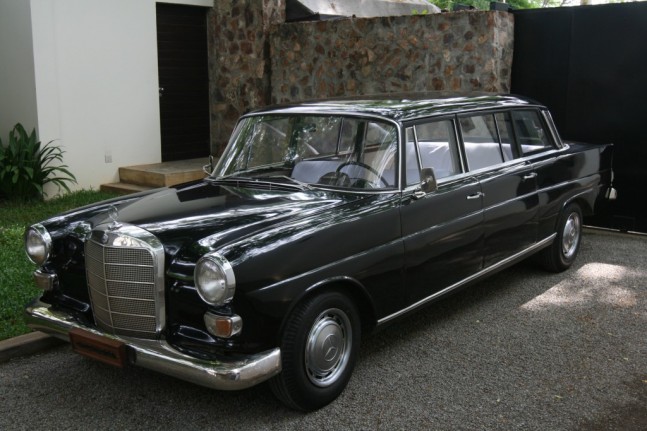
Indeed it is reiterated that you should not only feel at home but treat the whole place as “your second home” and that includes the affably relaxed dining room, which is open all day for you to eat at whatever time you like—sort of like going to your own refrigerator whenever you want, only there’s a chef there to cook for you!
Whilst you can apply this ethos to all Aman resorts and villas, you would not apply any sort of regularity or conformity as each location is totally unique and remarkably diverse—from the Amankora in Bhutan to Amanruya in Turkey, or the Aman-i-Khás wilderness camp on the fringes of the Ranthambore National Park in Rajasthan, India—the deft combination of simplistic luxury and stunning architecture—in phenomenal locations.
At the very core of Aman resorts is the lust for faraway cultures, and it is assumed that if you are staying at Amansara, you have come for one of the most extraordinary cultural experiences on this planet; to take in one of the Eighth Wonders of the World, the ancient temple city of Angkor, a UNESCO World Heritage Site.
Angkor had been at the top of our list of places to explore for many years but only at a stage when our daughter would be able to comprehend the significance of this lost city, the Khmer empire and its remarkable civilization; equally, appreciate the multifarious religious and cultural complexities, apart from the more perceivable visual splendour.
No question a field trip to Angkor is ‘right up there’ in the school geography stakes, little lone the countless explorers, theologians, archaeologists, anthropologists, historians, scientists, engineers, scholars and writers who have been fascinated, if not baffled, by the mystery of Angkor for centuries—and still to this day—click here to read National Geographic article ‘Divine Angkor’, by Richard Stone.
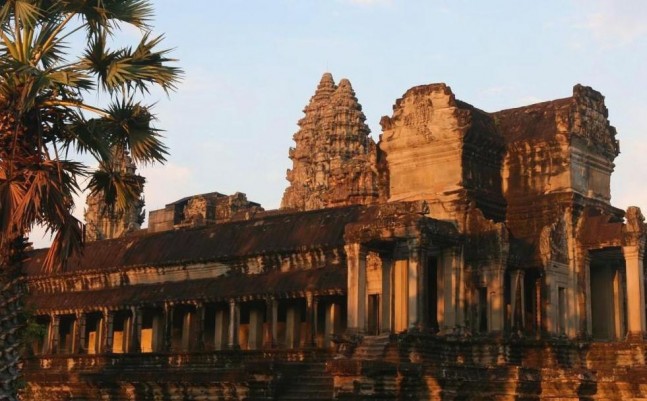
And you might well say staying at an Aman resort is hardly adventure-seekers doing it rough, perhaps even a little bit over the top for a 10 year-old, but trust me, she fitted in perfectly to her surrounds; I might add she is extremely well-travelled and counts the Connaught in Mayfair, London is one of her favourite hotels!
I can also tell you from our Amansara stay, and more the fact that we were only there two nights—barely one and half days exploring—not only is this resort experience unparalleled in Siem Reap, it is unquestionably the best place to stay to effectively maximise your time. In as much as a good hotel concierge in Paris is a lifesaver, the Amansara teams intimate knowledge of Angkor and Siem Reap along with their organizational talents and dedication to every detail of your visit will justify your whole stay alone.
We were greeted on arrival by the worldly, long-serving Amansara General Manager, Sally Baughen, a most charming and engaging New Zealander. You can be assured she is already totally up to speed on your stay and vetted all your arrangements and the bespoke excursions, exploring, shopping, eating and relaxing are all in hand!
Whilst many Aman resorts encompass mesmerizing surrounds and spectacular views, Amansara is more of an oasis from the bustling clutter of the main road to Angkor, hidden behind its walls, an encapsulated space of serenity that quietly embraces you with its majestically tall trees and eye-soothing black-tiled pool.
It was originally called Villa Princière, built in 1962 for King Sihanou, in the ‘Golden Age’ of Cambodia’s independence from France, as state guest house and created as modern intimate space to make both Western and Cambodian dignitaries feel at ease. The villa has been through many changes since, some tumultuous with the advent of the Khmer Rouge and subsequently occupied by the Cambodian Military in the 1980’s. Eventually it was returned to its villa guise and opened as Villa Apsara in 1992 with Aman acquiring the property in 2002, hence the combining of Aman and the shortened sara—Amansara
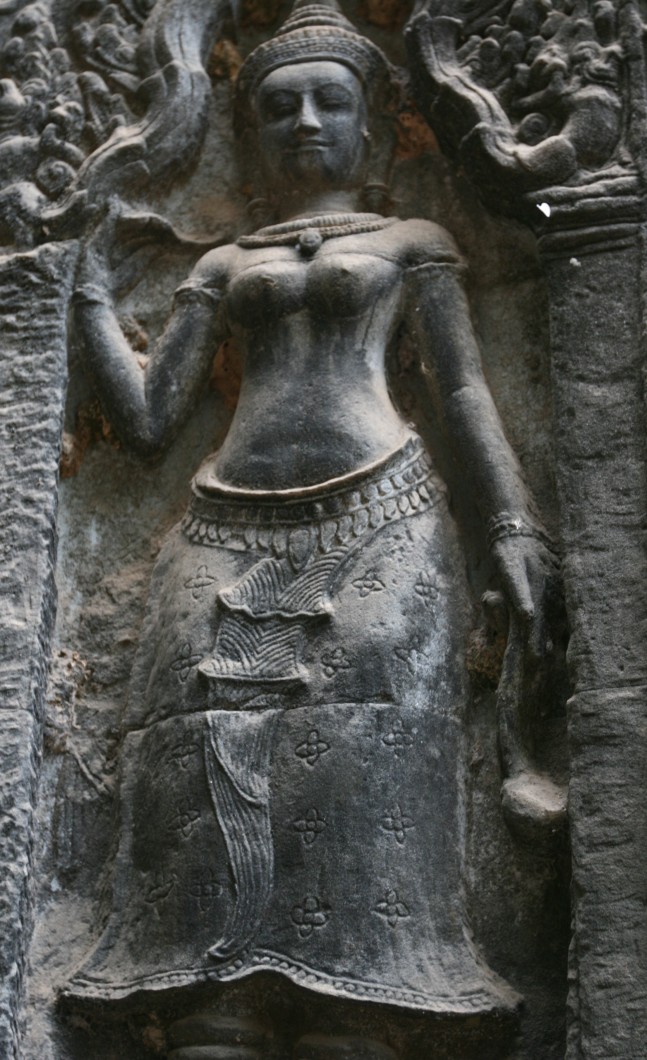
Devatas
At this point, it is relevant to grasp the difference between an apsara and a devatas as you will see many of them in Angkor. Apsara are beautiful supernatural female beings, the heavenly nymphs of ancient Hindu mythology and Indian dance depicted in the fascinating stone bas-reliefs throughout the temples of Angkor. The Khmer female figures that are dancing or are poised to dance are apsaras; the female figures portrayed individually or in groups who are standing still and facing forward in the manner of temple guardians or custodians are called devatas.
Both are captivating if not very suggestive and will know doubt preoccupy ones time and mind as your explore the temples; last count there were 1,976 devatas at Angkor Wat, so if your children’s interest wanes or your partner is showing signs of lethargy, send them off to count up all the asparas, but you might want to mention these nubile nymphs only entertain and sometimes seduce—gods.
Wasting no time, well, after a very pleasant late lunch first, we were introduced to our personal guide for our entire stay and the team of drivers who whisked us off in Amansara’s wonderfully restored (somewhat modified) World War II era US Army Jeeps, our impressive motorcade seemingly parting the traffic unhindered at a clip to the “Great City” and ancient Khmer capital, Angkor Thom, established in the late twelfth century by King Jayavarman VII, with its three main temples; the northernmost Lolei surrounded by an active wat (moat), Preah Ko (Sacred Bull), and Bakong, the first temple mountain built by the rulers of the Khmer empire.
Amansara recommends Angkor Thom as the ideal starting point for Angkorian exploring as it is relatively quieter than the other more popular temples, which becomes patently obvious when you encounter the relentless hordes of tourists (over 2 million annually) and countless locals thronging around them at Angkor Wat.
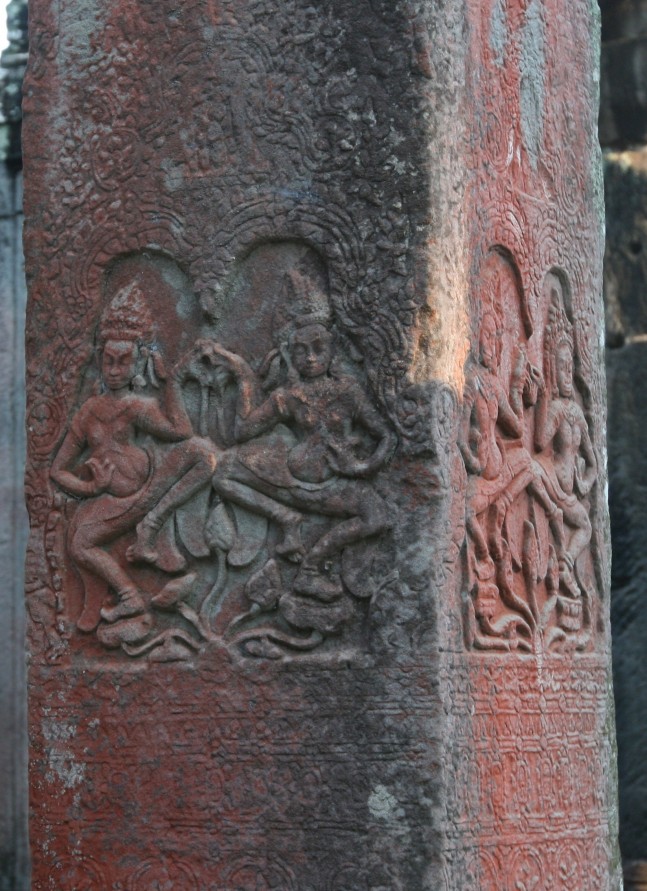
Apsara
Indeed, we were practically the only people at Lolei, which in itself is serendipitous as ones first encounter with Angkor architecture and its surrounds needs a good deal of meditative space as it is a thoroughly ruminating experience. It also gave our guide the opportunity to talk at length, effectively giving us the 101 on Khmer culture, religion, history, engineering; Kings building, Kings demolishing—some Kings building to reach the sky, others bringing it back to substratum—and all the wars and a multitude of transgressions in between.
No amount of research prior to your trip, or post-trip for that matter, will equip you for what you are about to experience visually, emotionally, intellectually and every other human perception. And should you go away contemplating embarking on a PhD on the Khmer empire, it’s probably likely that we (humans) will have discovered or visited a new civilization in another Universe by the time we work out exactly what happen here in Angkor.
Even as a travel writer, and history and anthropology enthusiast, it would be futile to write anything on Angkor other than our personal experience, words will simply never do it justice. Everyone will take away their individual reflections and theorizations on Angkor, and doubtless there will be compelling aspects that impress or intrigue more than others.
It could well be the sheer magnitude of Angkor, 1,000 square kilometres (390 sq mi) of urban sprawl and the largest preindustrial city in the world. Our guide proudly tells us this was the largest place of worship in the world, as big as the city of New York with in an estimated 750,000 to one million people connected by an elaborate infrastructure system.
It might be the complex architecture with its mind-boggling scale and extraordinary accomplishment of construction, surely as impressive as the the Great Pyramid of Giza. Or it could be the colossal water engineering feat; Angkor is considered to be a “hydraulic city” with its complicated water management network—the lifeblood of this civilization—was used for systematically stabilizing, storing, and dispersing water throughout the area and effectively combating the unpredictable monsoon season.
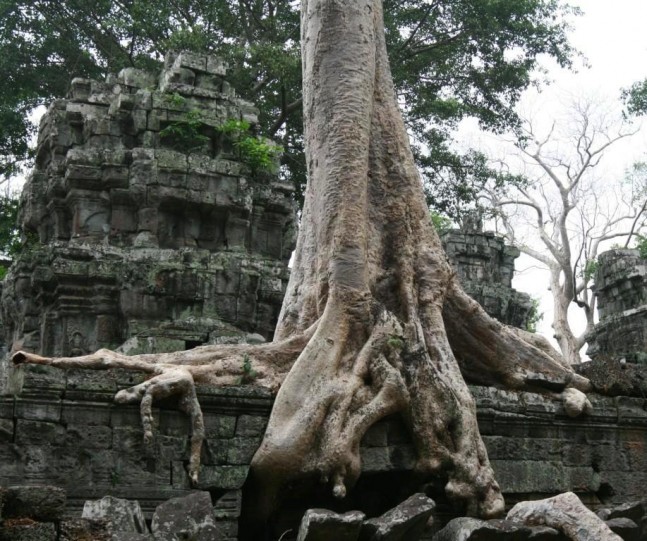 Many will of course associate with the religious cultures of Hinduism, Vaishnavism, Shaivism, and Buddhism and Theravada Buddhism and the worshipping of gods. Hindu gods live in heaven or their own ‘worlds’, thus the early temples where built to reach up into the sky for the Kings to communicate with the gods. That said, it is thought the Khmer empire began with the Angkorian period in AD 802 when the Khmer Hindu monarch Jayavarman II declared himself a “god-king”, one assumes to make it even easier to communicate with the gods–on the same level!
Many will of course associate with the religious cultures of Hinduism, Vaishnavism, Shaivism, and Buddhism and Theravada Buddhism and the worshipping of gods. Hindu gods live in heaven or their own ‘worlds’, thus the early temples where built to reach up into the sky for the Kings to communicate with the gods. That said, it is thought the Khmer empire began with the Angkorian period in AD 802 when the Khmer Hindu monarch Jayavarman II declared himself a “god-king”, one assumes to make it even easier to communicate with the gods–on the same level!
Where it gets even more intriguing is that some believe Jayavarman I from Funan was the first king of the Khmer empire, a Buddhist King, illustrating that both Buddhism and Hinduism coexisted relatively peacefully throughout ancient Cambodia under the dominant Hindu Kings, even if the occasional Buddhist King redesigned or rebuilt many Hindu temples with a more ‘earthly’ connection.
For me, the most compelling aspect of Angkor, indeed utterly captivating, is the fig trees and how (they) and the jungle engulfed an entire kingdom; these fig trees with their lava-like roots overpowering massive stone structures over thousands of years, the ruins lost for all time.
Some of the most alluring literature and photography illustrating this can be found in ‘angkor – A photographic portrait by Jaroslav Poncar and the chapter, Angkor: Forest of dreams, “Angkor greets the visitor not with buildings but trees. Silver-smooth, the flanged and buttressed trunks march in chaotic colonnades across the forest floor. Their scale is intimidating” – John Keay.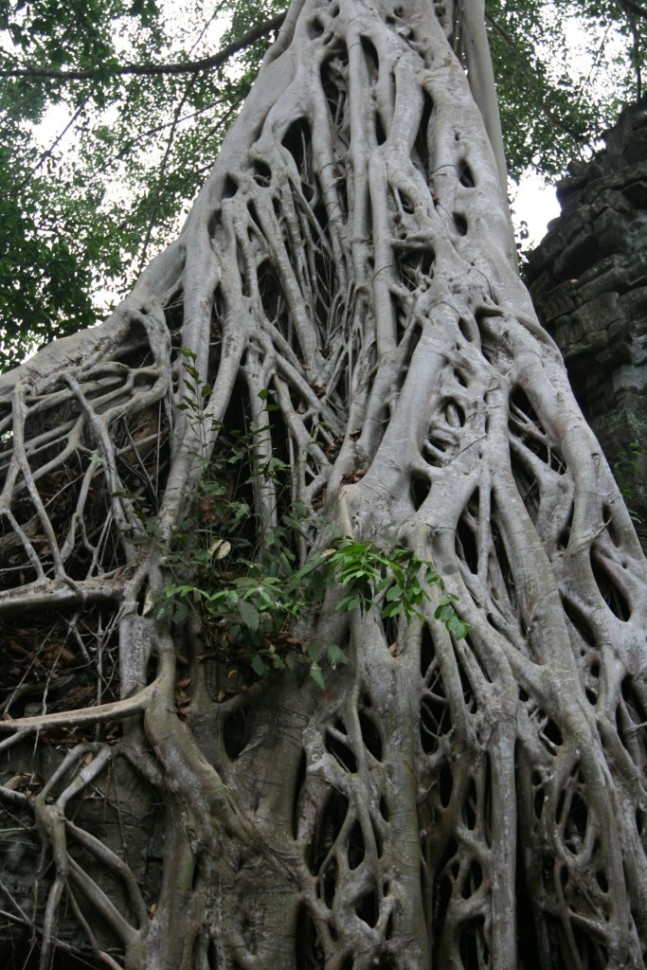
Equally enchanting is Pierre Loti, ‘Un Pélerin d’Angkor’ 1912 – “It is this fig tree that is lord of Angkor today. Everywhere, over palaces and over temples, which it patiently breaks apart, it spreads in triumph its pale smooth branches with their snake-like markings and its broad dome leaves. It started life as no more than a tiny seed, sown by the wind on a frieze or at the top of a tower. But as soon as it could germinate its roots thrust like delicate filaments between the stones and made their way downwards, guided by an unerring instinct, towards the earth and when, at last, they meet it and rapidly swelled with life-giving sap until they became enormous, breaking everything apart, destabilizing everything, rending immense walls from top to bottom. From the moment the building was lost, its fate sealed…”
It was is about 4pm by now and the burning April afternoon sun is bearing down us permeating through the trees and jungle foliage, but that does not deter us from our exploring and archaeology, as if we stumbled onto a lost civilization all by ourselves…and at times it felt like we were on the set of Rudyard Kipling’s ‘Jungle Book’, or ‘Lara Croft Tomb Raiders’.
Heading back to Amansara, our guide suggested we do a drive-by of the most popular of all temples, Angkor Wat, warning us that it was best to avoid the throngs of tourists all looking for the ultimate sunset photo with its massive moat and structure bathed in the early evening sun; unlike most Angkorian temples, Angkor Wat is orientated to the west.
Rather cryptically, our guide tells us not to worry about missing out on Angkor Wat, as we would be back tomorrow morning and have it all to ourselves. And return we did, in the denseness of darkness in the morning, and I mean early morning—5am! And that entailed being gently woken up by the Amansara staff at 4am for pastries and (strong) coffee, then sneaking away from the compound with our motorcade of US Army Jeeps, our platoon of minders looking measurably more conscious than we were.

And when I say darkness, that sort of density of darkness when you cannot see six inches in front of you; that eerie feeling of pitch blackness that envelopes all of your body and senses. Once your past the guard entrance, there is no artificial light whatsoever at the back entrance of Angkor Wat, actually there is no signage and no sign of anyone and its seems like our guides covert mission is going to plan.
Dismounting from our motorcade and continuing on foot with just our guide, we crept along a track for what seemed an eternity, the jungle trees extinguishing any sense of one’s bearings. Eventually our night vision slowly allows us to make out the shadows of the outer compound walls of the temple and the very first hues of morning twilight provide a glimpse of the massive lotus flower shaped central tower silhouetted against the violet dawn sky.
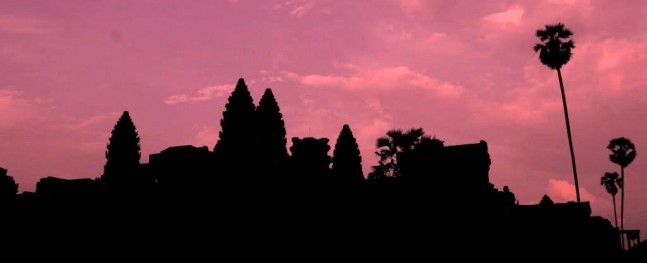
As we get closer our field of vision takes in the two southern towers of this quincunx structure, the geometrically designed five towers that symbolize the five mountain peaks of Mount Meru, the home of the gods and cosmologically the centre of all the physical, metaphysical and spiritual universes.
Climbing up several levels of steps we reached the outer gallery and what would appear to be the perfect vantage point and open to the outside of the temple, with a columned half-gallery behind us buttressing the inner gallery. Clambering upon one of the large stone lions guarding this entrance, in our prime position we watched Angkor Wat unveil itself from darkness with the sunrise bathing it in sepia colours, the temple seemingly coming alive as every shadow and texture reveals itself to this light of heaven—Hinduisms sacred twilight hour, neither day or night, Godhulivela— ‘cow dust time’.
We sat silently absorbing this wondrous experience, somewhat speechless as here we were with the world’s largest religious monument all to ourselves, in our cogitative silence contemplating the monumental measures undertaken by the 12th Century Khmer King Suryavarman II to build this state temple dedicated to Vishnu, the Supreme God of Vaishnavism and his ten avatars.
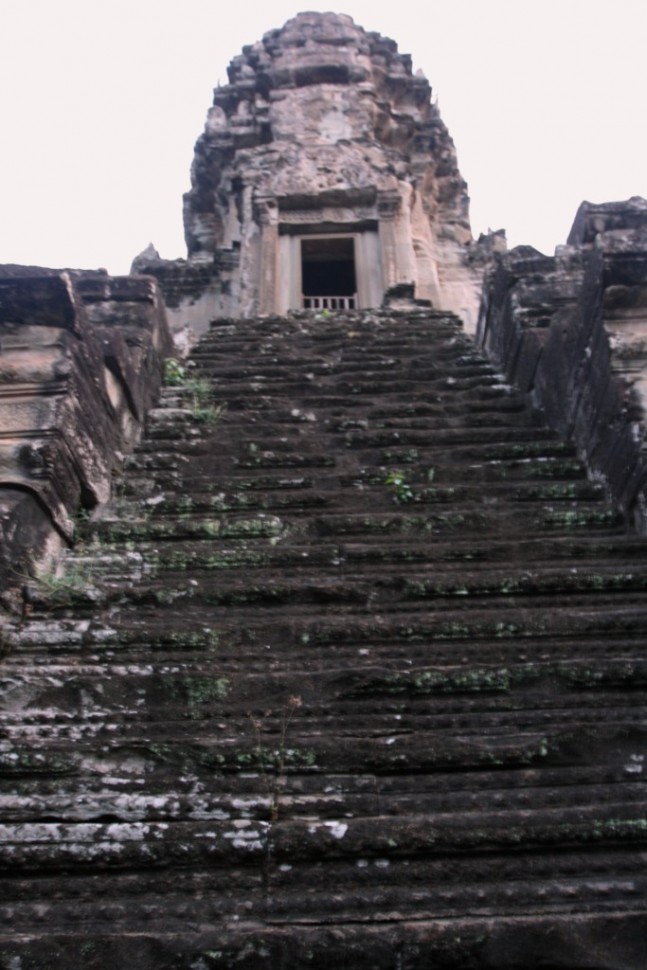 Our preternatural state of mind was suddenly broken by the deafening chorus of cicadas seemingly choreographed by the dawn, natures crepuscular bringing us back to earth. The shafts of light were now streaming through the inner walls of the outer gallery bringing to life one of the fascinating bas-reliefs depicting the procession of Suryavarman II and the 32 hells and 37 heavens of Hindu mythology.
Our preternatural state of mind was suddenly broken by the deafening chorus of cicadas seemingly choreographed by the dawn, natures crepuscular bringing us back to earth. The shafts of light were now streaming through the inner walls of the outer gallery bringing to life one of the fascinating bas-reliefs depicting the procession of Suryavarman II and the 32 hells and 37 heavens of Hindu mythology.
We spent the early morning hours exploring Angkor Wat doing our level best to take in as much as we could within our limited time. If I could give one piece of advice for exploring Angkor Wat, it is imperative that you have a certified personal guide who has a good knowledge of Hinduism, as we did. Whilst there is no shortage of visual splendour that is easy to appreciate it is the extensive detail in the bas-reliefs friezes of the outer gallery, a series of large-scale scenes depicting episodes from the Hindu epics that are most impressive; to quote the well-respected British archaeologist, Charles Higham, “The greatest known linear arrangement of stone carving”. As visually intriguing as these bas-reliefs are, they are infinitely more compelling if you have a guide that can translate and tell the fascinating myths, stories and incredible history.
I would also warn against climbing the steps on that lead up to the central or corner towers and gopuras of the inner gallery. These very steep ‘stairways’ represent the difficulty of ascending to the kingdom of the gods and best left to Kings to scale, if you get my drift.
For modern-day Angkorian explorers and Sybarites such as us, retiring back to Amansara after each days expedition for a much needed shower and a little relaxation in the pool or luxuriating in ones suite is a most welcome sanctuary.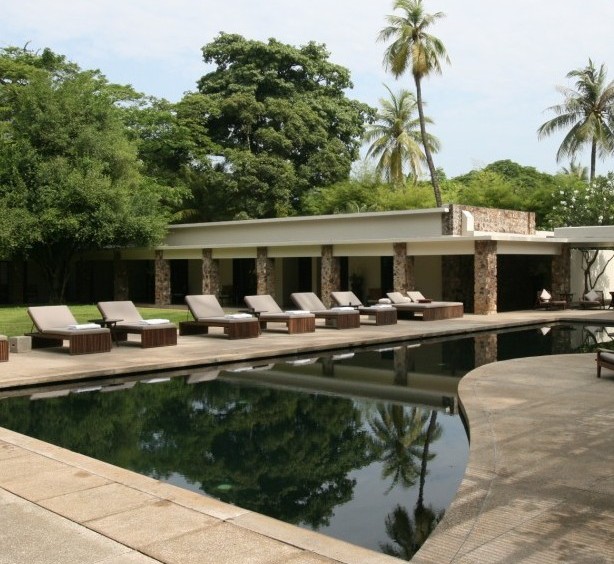
And with all our adventure seeking we were ravenous and looking forward to some gastronomic exploration in the Amansara dining room, which is itself a rather unique space, completely round and expansive with its 30 foot ceiling. Actually it was originally where King Sihanouk once enjoyed screening his collection of movies.
Taking in the modern and simple lines of the building you start to absorb the painstaking renovations, immaculately restored by Aman to its original look using photographs and local knowledge, one gets the sense the original design wanted to avoid any replication of ancient Angkorian architecture as it would be an insult to try, and the simplicity of Villa Princière makes you appreciate the intricacy and wonder you have just experience all the more.
It is indeed a very comfortable space and the informality of the service adds to ones feeling of ataraxia, as does the lack of pretence in the concise menu and wine list. Whilst good food, wine and hospitality at Aman resorts is paramount, foam and fuss is not and homogeneous with the philosophy of Aman’s founder, Adrian Zecha, who believes that his guests have had their fair share of fine dining and the last thing they want on vacation is complicated, overworked food.
Having met Amansara Chef, Molly Rygg, at lunch on our first day, and having a lengthy discussion on her approach to the menu and our personal requirements, you appreciate the magnitude of her job and the creative challenge of her daily changing menu. Moreover, in the conversation one quickly senses her passion and obsession for food foraging and her bourgeoning attempts to establish their own vegetable and herb gardens and motivating local growers with a keen desire to implement locavore and farm-to-table aspects.
That said, the reality is a good deal of produce has to be brought in from outside of Cambodia to cater for the kaleidoscope of international palates, her job further complicated by the intricacies and eccentricities of the guests personal needs and desires. But Rygg seems to relish in all this and enjoys discussing it with you directly and articulates well, indeed it is refreshing to have such an engaging and lucid chef.
Looking after us was relatively easy as we were only dining one night at Amansara, but imagine how creative a nutritionist Rygg has to be with guests who stay for two or three weeks, sometimes longer and with many regular return guests coming from as far away as New York.
We decided that between the three of us sharing dishes we could indulge in the entire menu for that evening taking in a number of Khmer dishes as well as satisfying my sudden craving for a decent steak! Yes I know, you come all the way to Cambodia for a steak, but hey that’s what Aman hedonism is all about–no rules, no guilt.
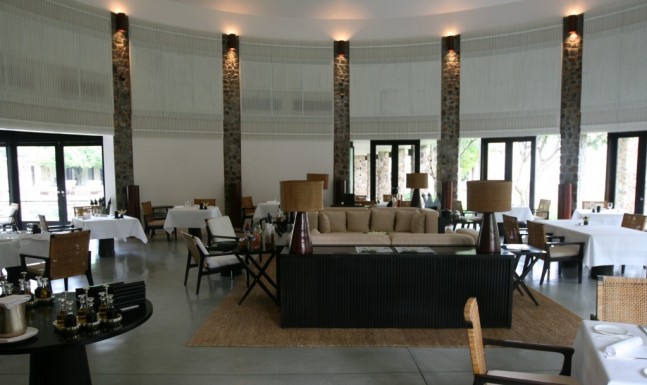
Amansara dining room
Mind you, I am starting to think my daughter has a more adventurous palate than me, indeed she is already quite the gourmand, but even I was surprised by her enjoying a local beef tongue dish, whilst her dad was working his way through a much more orthodox although superb sirloin of Australian Black Angus beef. Actually my steak came with a sauce made from locally grown pepper, which is what caught my eye in the first place, in terms of a perfect wine pairing with a Syrah I had noticed on the wine list.
At this juncture I have to mention the wine list and cellar, which is also concise, however is a wonderfully eclectic mix and as Aman regulars have come to appreciate there will always be some fascinating wines and older or rare bottles, no matter which Aman resort you are in, and that can be in some seriously exotic and remote parts of the world.
I had quickly spotted the Bonny Doon Cigare Volant 2003 which looked like pure wine hedonism to me moreover, enticed my steak craving mood even more with the thought it would match perfectly with the locally sourced pepper used in the sauce adorning the beef. What’s more, 2003 is my daughters’ birth year, so we all got an extra emotional buzz out of liberating this wonderful bottle.
Equally, it seemed fitting that this wine is made by the hedonist winemaker and most sensualist wine writer on planet earth (there’s always a chance he will be the first person to make a wine on another planet), Randall Grahm, author of the outrageously humorous and profoundly engaging “Been Doon So Long” www.beendoonsolong.com
Actually, I did have a certain expectation that our wine experience here would be sufficiently stimulating, with some inside knowledge of the workings of the Aman wine program, having personally known Aman Resorts global food and beverage manager/executive chef, Richard Genn, for over twenty years.
Genn is based in Singapore at Aman headquarters, but is constantly on the move between Aman resorts all over the world, finessing existing properties, opening new ones, and endlessly solving culinary logistics and empowering his chefs. He is your quintessential ‘chef’s chef’, thoroughly restaurant savvy and has a perspicacious comprehension of the diners needs, moreover, one of those rare chefs who talents extends to wine and he has an incredible palate and extraordinarily broad knowledge of fine and old wines.
Knowing our preoccupation with food and culinary inquisitiveness, Sally Baughen had thoughtfully arranged for us to dine the following night at Cuisine Wat Damnak, as it is unquestionably the best modern Cambodian cuisine in the country and Chef Joannès Rivière the equivalent food historian and renaissance man/chef in Cambodia as the legendary Chef David Thompson is to Thailand.
Chef Joannès has been immersed in the culinary world from an early age working in his family restaurant near Roanne in the Loire and you can sense his classical training and French genes in the skilfully executed degustation menu with an impeccable attention to detail and individuality in each dish. However the ethos here is locally sourced, fresh seasonal produce with the emphasis on the regions unique fruits, vegetables, plants, herbs and spices, both cultivated and gathered in the wild, along with daily visits to the Siem Reap markets and local women’s’ cooperative to source what is at its freshest best, including native freshwater fish and shellfish from the Mekong and Tonle Sap lake.
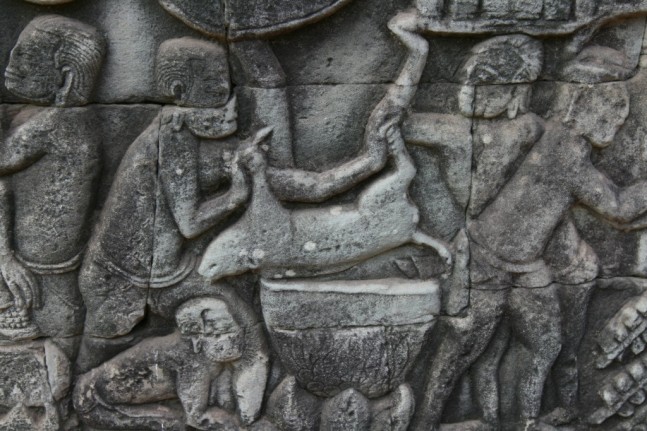
Interpreting what defines modern Cambodian cuisine is as intriguing as the complexities of the Khmer empire itself and influenced by indigenous and foreign cultures, both past and present. There is evidence of the Kingdom of Champa a breakaway Chinese seafaring culture that invaded Cambodia with its roots as far back as second century AD and a fascinating transition and evolution as colony with its infusion of Indian and Islamic culture. There are the regional confluences of China, Vietnam, Laos, Thailand and a myriad of ethnic cultures that in more recent times shaped Indo-China along with the subsequent French colonialism.
Perhaps the soul of Chef Joannès modern Cambodian cuisine lies in his own evolution, eschewing the western culinary world he had became disenchanted with and coming to Cambodia as a volunteer cookery teacher at the French NGO-run Sala Baï Hotel School in Siem Reap, teaching cooking and hospitality skills to underprivileged young Cambodians. He went on to write the school’s cookbook, one of the first cookery books about Cambodian food ever written and internationally published both in French and English.
Located in a colourful and informal setting, both indoors and outdoors, of a former traditional Khmer house in a quiet neighbourhood of Siem Reap, the restaurant is just 500 metres from the temple Wat Damnak, to which it takes its name. Chef Joannès charming wife, Carole, runs the front of house with an exuding friendliness and infectious enthusiasm when guiding you through the two set degustation menus on offer and I found the whole experience totally engaging yet suitably relaxed. Indeed, it is a wonderful juxtaposition to the somewhat chaotic central Siem Reap and the bustling markets, local stalls and more rustic street food.
I would suggest dinner at Cuisine Wat Damnak is an imperative for anyone that enjoys their food, moreover it is incredibly affordable given the quality of food and skill of cooking and if I were staying around Siem Reap for more than a week, I would definitely go for a return visit as the menu changes every Tuesday and there will doubtlessly be new ingredients to discover. Putting that into perspective, Cambodia has over 1000 species of freshwater fish so there’s a fair chance you will be experiencing something new!
For those seeking a more intensive emersion in the local produce, a visit to Pasa Ler (Big Market in Khmer) is a must and one of Amansara’s kitchen brigade can guide you through the maze of passage ways at the market, followed by a visit to a noodle shop to watch the preparation of nom ben chok, fresh rice noodles.
Equally strategic for all guests of Amansara is a visit to their Khmer Village House located near the Angkor temples and where you can take a class in the preparation of Khmer dishes in a traditional kitchen under the instruction of one of the resorts Khmer chefs. Not only do you get to enjoy what you have cooked, more importantly, you now have a lifelong memory to share with others with the Khmer menu that you can easily prepare and entertain friends at home.
Needless to say you will take away many memories from Angkor. For me personally, the most indelible impression I have from our trip is our farewell from Amansara. All the staff came out to see us off with a collective wave goodbye, and I mean all the staff; from cooks, front of house, back of house, housekeeping, gardeners, drivers, managers–EVERYONE! This presented a great photo opportunity, at the same time quite emotionally overwhelming and a very special moment underlining the ‘Aman Family’ ethos.
Amansara is an extraordinary experience, in an even more extraordinary setting and perhaps many would view it as a once in a lifetime experience, but like the alluring intrigue of the Khmer empire, I would do it all again tomorrow.
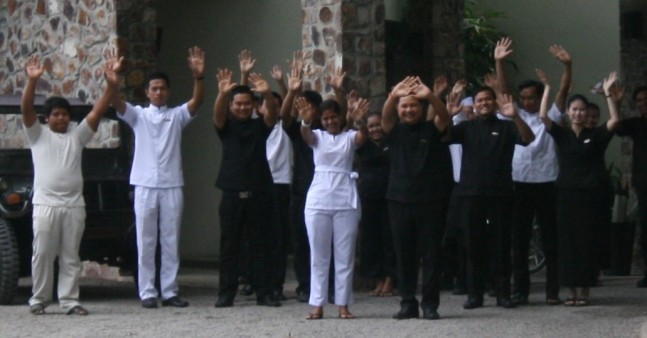
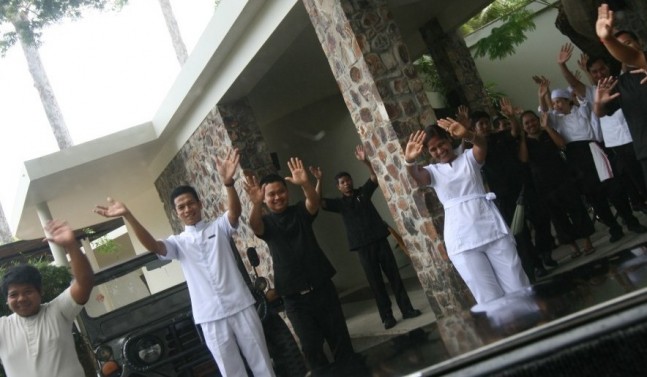
Amansara, Road to Angkor, Siem Reap, Kingdom of Cambodia Tel: (855) 63 760 333
Sally Baughen General Manager, email: sbaughen@amanresorts.com www.amanresorts.com
Footnote
Tourism is now the lifeblood of Angkor, but beware the beggar children, buying the cheap trinkets they hawk is unlikely to benefit them directly and it is more constructive if you give generously to one of the certified local charities: Amansara has put together a directory that lists organizations and individuals that can be trusted and supported. These organizations cover a broad spectrum of social concerns from performing arts, children and women’s health, higher education, de-mining, handy craft, cultural heritage, and the preservation of wild life. Also International foundations such as The Ponheary Ly Foundation http://theplf.org/wp/ or the Sala Baï Hotel & Restaurant School Sala Baï Hotel School “Give wings to young Cambodians full of hope and potential to contribute to their training through sponsorship, donation or even booking a holiday or going to lunch at our Hotel and Restaurant School.”
|
|
Tweet |






No comments to Luxuriating with the Gods – Amansara, Angkor | Comments Feed
No comments yet
The comments are closed.